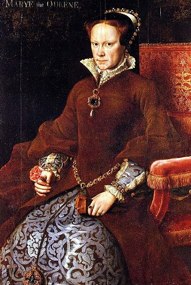Ever Wondered Who Bloody Mary Really Was?
Posted by Justin on October 9th, 2009Bloody Mary is the Monster of the Week! Matt Finley explained some of the ghastly woman’s other talents on Monday. Wednesday he explained exactly why you’ve been hoodwinked into calling her out all these years..
 With all the varying verbal harpoons fired out into the ether to drag Bloody Mary back into the living world, it’s easy to forget that, though the current urban legend has been disassembled and reconfigured, often to the point of unrecognizability, the first fearful, double-dog-dared invocations of Bloody Mary were spoken with Mary I of England in mind.
With all the varying verbal harpoons fired out into the ether to drag Bloody Mary back into the living world, it’s easy to forget that, though the current urban legend has been disassembled and reconfigured, often to the point of unrecognizability, the first fearful, double-dog-dared invocations of Bloody Mary were spoken with Mary I of England in mind.
Mary I (not to be confused with Queen Mary of the Scots, who is often wrongly identified as the crotchety mirror-dwelling apparition) was the only child of Henry VIII’s first wife, Catharine of Aragorn, to survive into adulthood. Despite being unfavored and disregarded by her family, she received the crown in 1553 after her half-brother Edward died of tuberculosis. Bloody Mary went on to earn her macabre epithet when, after officially restoring Roman Catholicism to Great Britain, she began rounding up Protestant leaders and burning them at the stake, igniting a flurry of religious riots and violence. The most enduring modern connection to the story is any variant of the game in which summoners must speak the words, “Bloody Mary, I killed your child”- Mary I became so obsessed with producing a male heir that she endured two phantom pregnancies, during which she firmly believed she was carrying a child that was then somehow miscarried or aborted.
Generalizing for purposes of brevity, the origins of Bloody Mary as a Protestant horror story belie the deeper history of both a uniquely Protestant fascination with the occult and a trend of propagandized anti-Catholic gothic literature. Unlike most 16th century Catholics, whose faith was entrenched in dogma, hierarchy, tradition and ritual, many Protestants, especially in Ireland, believed in ghosts and superstitiously permitted the occult to fill in certain gaps that existed in the post-enlightenment thought that Protestantism so thoroughly embraced. Beyond assigning Mary I her now-infamous soubriquet (despite the fact that, in reality, the queen didn’t execute any more people than her Protestant father), the Protestants were later known for distributing pulp novellas that portrayed convents as dark caverns of orgiastic chaos with priests travelling through underground tunnels to engage in violent fornication with nuns, yielding innumerable illegitimate children that were then disposed of by horrific means. Given these factors, it’s easy to understand how a violent, Catholic threat to the Protestant faith was transformed into a vengeful specter – a zombified appendage of history reaching out at the giggling great grandchildren of unjustly murdered Anglicans.